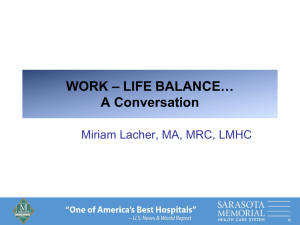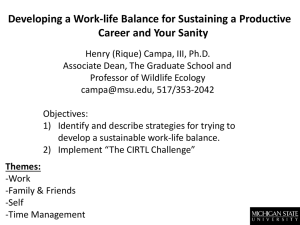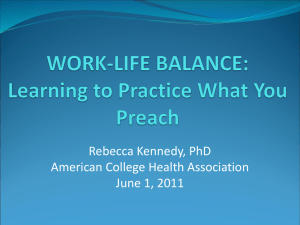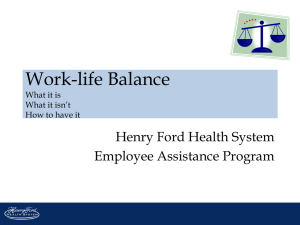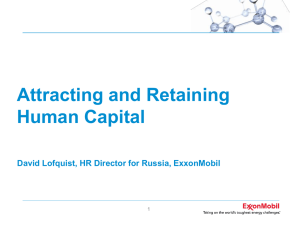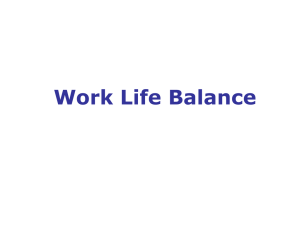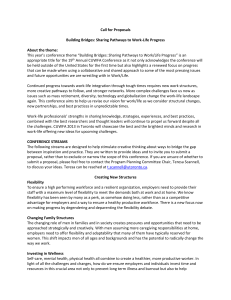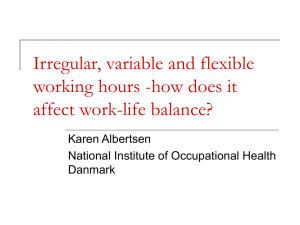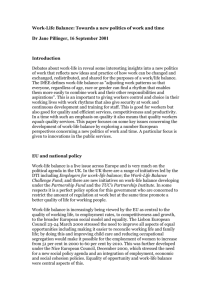Work and Life Balance
advertisement
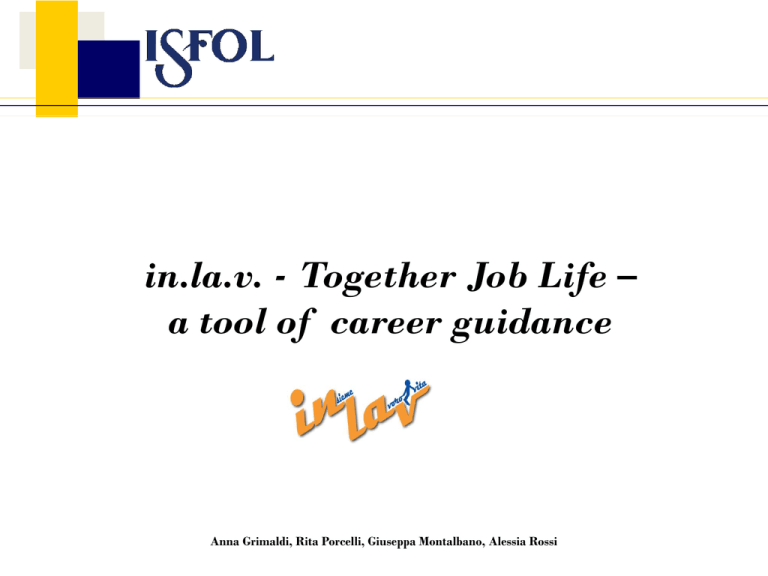
in.la.v. - Together Job Life – a tool of career guidance Anna Grimaldi, Rita Porcelli, Giuseppa Montalbano, Alessia Rossi In work and family research (Allen, Herst, Bruck, Sutton, 2000), life satisfaction is frequently included as a result or a consequent variable but, beside the direct relation between life satisfaction degrees and work-family conflict, what is important is how people deal with these conflicts. However, it is commonly believed that the work-life balance issue does not concern only the family sphere, and the growing interest for this topic is reflected in mass-media, in local governance policies and in the development of dedicated community programs. Many experts on this topic frequently say that it is still difficult to embrace the idea that the needs and interests of people at work are not necessarily in contrast with those of the organizations/companies and that, on the contrary, working together for solving work-life conflict might generate benefits for both the employee and the organization (Thompson, Beauvais, Lyness, 1999; Thompson, 2002) In the monographic issue of Harvard Business Review dedicated to “Work and Life Balance” (2000) this topic of “conflict of interests” is examined referring to a former contribute from Friedman, Christensen, DeGroot (1998). According to these authors, managers and organizations are not yet prepared, or sufficiently attentive, to recognize and sustain the person in his/her entirety. It is frequent to think that thriving for a better organizational and personal wellbeing is an issue to deal with once one holds a job position or is socialized into a determined corporate culture, and not before. The preventive view and “damage reduction” as intended here is instead typical of career guidance, which acts as transversal element on the different needs of choice and career planning. In this context, the topic of work-life balance is proposed less in its negative acceptation of “solution between contrasting parties” and rather central is the reference to the concept of empowerment and research of opportunities. Empowerment interventions, especially in studies about gender, focused the problems of work-life balance as cultural problem and problem of mentality, and the effort must be in the direction of a change in habits and practices. Beside this important and sharable objective, guidance practices and career development emphasize the combination between internal/external: where “internal” refers to the subjective way of perceiving roles and associated emotions, while “external” refers to the change of the contexts that facilitate balancing and sharing: rules, values, information, quality of work environments. From this two levels of attention originates the involvement and the interest of the Guidance Policies Unit - ISFOL for the work-life balance topic. In this complex yet stimulating scenery, the idea of setting up a guidance counseling program was considered; a program which considers work-life balance from a preventive point of view; in other words, a process aimed to make aware on work-life balance people accessing the employment services throughout a net of tools and information specific on this topic. The first step was building a network of people and referrals that could relate different needs from different locations and facilities spread all over the country. The next step was designing and sharing a program to be experimented locally, and to be verified as for operational feasibility. Goal “redefine the resources for personal and professional life, allowing individuals to be able to have instruments in order to look for solutions and to take decisions in view of a project of development”. This study presents a project of action-research, realized by IsfolGuidance Policies Unit in collaboration with the consulting firm Polis 2000 from Turin, Italy. It followed the European guidelines on employment policies 2005-2008 about encouraging actions for eliminating differences among men and women in occupation matters and allowing a better work-life balance (Grimaldi, Porcelli, Rossi, 2007; Isfol, 2006). The Isfol “in.la.v.” program: Objectives The counseling program with guidance purposes "in.la.v - Together Job Life" represents a resource for guidance professionals of public and private employment services and for all people that perceive their professional future as problematic in relation to different aspects of their life. This research approach (Grimaldi, 2005) aims to adopt a preventive perspective, where guidance action is conceived as a transversal element to the different needs of choice and work placement. In this view, the topic of work-life balance is intended less in its negative acceptation of “solution between contrasting parties”, but rather is central the reference to the concept of empowerment and research of opportunities. The general purpose of the program is guiding and sustaining vocational and professional choices, fostering the conditions for a change in terms of time, means and strategies for balancing paid work and private life. In particular, the definition of private life should be considered in a wider acceptation that considers not only the dimensions typical of family life, but also space and time for one-self. The program goal is ‘guidance’ as it informs, trains and supports actions of career planning and re-planning which are read with a new sensitivity and knowledge of an original way of “keeping together” life and work. A second aim of Isfol “in.la.v” program leads to the knowledge and the ability of using the resources from the context, so that a person can take into consideration all the “help” on his/her territory. The program’s beneficiaries The in.la.v program is addressed to everyone, men or women, who express an interest/ a need related to work-like balance. The beneficiaries of the intervention are defined essentially by their request: people with different family conditions, who are on different phases of their life cycle and on different career paths. The articulation of the program The Isfol in.la.v. program consists of individual interviews and group activities, for each of whom ad hoc original instruments were elaborated. It is conceived as a modular structure where the interchanging of individual and group situations is decided by the guidance practitioner in relation to both users’ and service organizations’ needs. The modules of in.la.v. project are nine: three are part of the preliminary phase, which comes first than the actual counseling program; three modules are group activities; and three are individual interviews about the same contents of the group meetings but held with different conditions and instruments. Figure shows the three preliminary modules of the in.la.v. program which cannot ignore them nor be limited to them. More in detail, the welcoming and the request assessment are the first step to start any counseling program, and so they are widely explorative. THREE PRELIMINARY MODULES TO LA.V. PROGRAM Welcome and access requests (of work-life balance) Balance stories: in-depth interview Make aware about work-life balance topics: informative session After this first phase, the program consists of other three modules with two method options: group session or individual interview. These two options are alternative and so were designed depending on the type of setting and with different objectives and leading styles. As shown in figure, the main themes are: •Time and space: acquire a greater awareness of one’s opportunities and resources for developing a more efficient planning of life and work times •Resources and experiences: let emerge competences and resources - from previous individual, couple, family or social life experiences •Constraints and opportunities: think about constraints resulting from common stereotypes in order to stimulate the assumption of a critical position. Sustain information and experiences sharing in favor of a better possibility to balance. THREE MODULES– TWO METHOD OPTIONS MODULE “Time and space” Group session Individual interview MODULE MODULE “Resources and experiences” Group session Individual interview “Constraints and opportunities” Group session Individual interview The experimentation This study involved 34 guidance services in different Italian regions, 28 guidance practitioners, 73 users and 13 tutors. The experimentation was structured in the following steps: at first, Isfol-Polis research group trained the professionals. Then, the professionals realized the program on the field, under the tutorship of the research group. Finally, the evaluation phase started, with different objectives. The first objective was to evaluate the actual feasibility of the program in the Employment Agencies. The second objective was the re-designing based upon the feedback given by the different actors involved, that is guidance practitioners, users, tutors, supervisors of the involved structures. A further objective was the evaluation of the impact of the performed program (users’ follow up). The instruments set up and administered were: •a questionnaire for evaluating customer satisfaction; •a follow-up structured questionnaire to verify the impact of the program. As for the comprehensive evaluation of the program (Likert Scale from 1=false to 7=true) the users expressed high satisfaction, with values greater than the average of 3.5 (see graphic 1). How do you evaluate the in.la.v isfol program? 6,2 6,2 5,8 5,4 5,2 Average values 4,5 5,3 In particular, users think that the program is useful at personal level (mean 6.2) and interesting for the contents (mean 6.2), but also stimulating for the methodology (mean=5.8), well-structured in the planning (mean =5.4), matching initial expectations (mean=5.3), useful for the job (mean=5.2) and finally demanding for the time (mean=4.5). The working environment instituted with the counsellor is considered very good, with a mean of 6.8 out of 65 respondents. The average score for general satisfaction is also very high: 6.2 out of 65 respondents. Finally, the evaluation of the self-confidence in being able to realize one’s plan of action (Likert scale from 1=”completely unsatisfied” to 7=completely satisfied”) has a average score of 5.6 that indicates a very high confidence. N Mean Standard Dev. 65 6,8 0,4 65 6,2 0,8 66 5,6 1,1 How do you comprehensively evaluate the working environment created with your counselor? At the end of the program how much are you satisfied with the program? How much confidence do you have in being able to realize your action plan? Future perspectives The complexity of our productive and social world, the presence of new individuals from different cultures entering the labour market, the flexible organization of workplaces reveal the need to move from a working context to another, from a social role to another. This certainly involves the decisional process and influences life choices, especially in relation to the more significant transitions of the life cycle, as entering the job market, getting married, having children, etc. It becomes important to cope with the different and continuous requests from the different social contexts. Future perspectives This balance game needs competences that are different from some time ago, testifying the transfer from specialist competences to transferrable competences, which are able to modify and adapt in this ongoing and lifelong transition of roles, which are often acquired in informal ways. In this context, the competence consists of and is enriched by individual and subjective factors, and is being shaped as the ability of putting together and organizing knowledge and resources to efficiently deal with a new personal and/or professional situation (Grimaldi, 2007, pp. 291) Future perspectives This new scenario on one hand shows an increase and a diversification of the guidance requests and on the other imposes a reflection about the policies that rule this sector and about the future role of professional practice. All this is in accordance with the European guidelines for occupational policies 2005-2008 in sustaining actions for eliminating differences among men and women in occupation matters and allowing a better work-life balance. Future perspectives In line with all the exposed arguments about the complexity of life and the balance among the different social and professional roles, the idea and concept of lifelong guidance is consolidating, where professional interventions must become strategic instruments not only for identifying ones’ competences but also for developing new knowledge and competences. That means conceiving a self growing purpose of guidance (Grimaldi, 2005), which has to reinforce, in women and men, the ability to move autonomously between inside and outside, past and present, present and future. Future perspectives Guidance policies and the consequent planning of intervention must invest in sensitive and qualified services that must satisfy some requirements for guidance - theoretical, cultural, but also technical and methodological. In order to favor new perspectives and develop behavioral strategies able to sustain people in elaborating their life project, we must take into account the holist approach of individuals, understanding all the elements crossing their life cycle. Beneficiaries of guidance can find a valid service if the actions lose their exclusive informative value towards a valence of training, a systemic study of these issues can provide significant suggestions for developing innovative policies.
